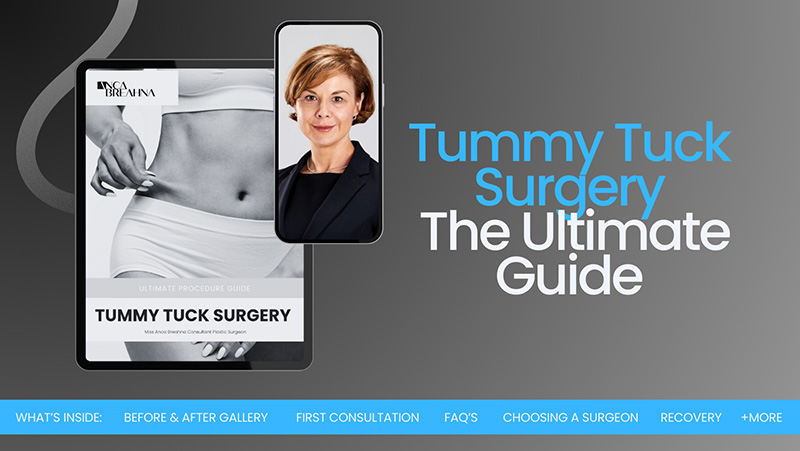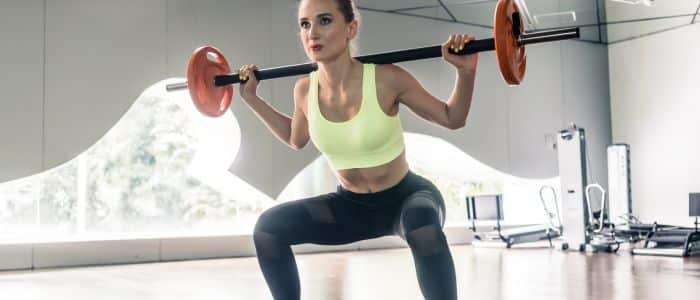
What Causes Split Tummy Muscles?
Split tummy muscles or Diastasis Recti refers to the separation of the abdominal muscles, specifically the rectus abdominis. This condition is commonly seen in pregnant women but can affect anyone, including men. It’s a physical change where the connective tissue (linea alba) that holds the abdominal muscles together becomes stretched and weakened, causing a gap. The rectus abdominis muscles, often known as the ‘six-pack’ muscles, are held together by the linea alba. When these muscles separate, it can lead to a bulge or ‘pooch’ in the abdomen. While often considered a cosmetic issue, it can also have significant health implications, affecting core strength and stability.
Consultant Plastic Surgeon Anca Breahna, based in Chester, UK, is renowned for her expertise in the field. She stands out as one of the most in-demand female Plastic Surgeons in the UK, specialising in body contouring including procedures like abdominoplasty.
Download the Tummy Tuck Guide

Common Misconceptions about Split Tummy Muscles
There are many myths and misunderstandings surrounding Diastasis Recti or split tummy muscles, which can lead to confusion or mismanagement of the condition.
- Myth: It Only Affects Women: While prevalent in pregnant women due to the stress placed on the abdomen during pregnancy, it can also affect men, particularly those with significant weight fluctuations or who engage in intense abdominal workouts
- Myth: Exercise Always Helps: Certain exercises, especially those that strain the abdominal wall like sit-ups or crunches, can actually worsen the condition
- Myth: It’s Always Permanent: With proper management and treatment, many individuals can reduce the separation and improve the condition’s physical effects
Causes of Split Tummy Muscles
Understanding its causes is key to both prevention and effective management:
Pregnancy and Childbirth
Pregnancy is the most common cause of Diastasis Recti. As the uterus expands, it puts pressure on the abdominal muscles, often leading to their separation. This is more likely in the case of multiple pregnancies, large babies, or closely spaced pregnancies.
- Hormonal Changes: Hormones released during pregnancy, like relaxin, soften the connective tissue, increasing the likelihood of muscle separation
- Postpartum Factors: The condition often becomes more noticeable after childbirth, as the abdomen contracts back to its pre-pregnancy size
Weightlifting and Exercise
Improper or excessive weightlifting and certain types of high-intensity exercises can contribute to the development of Diastasis Recti, especially if the core isn’t properly engaged.
- Incorrect Technique: Performing exercises that place excessive pressure on the abdominal wall, like traditional sit-ups or heavy lifting without proper form, can exacerbate the separation
- Lack of Core Strength: A weak core can increase the risk, as the muscles are less able to support the abdominal wall
Other Contributing Factors
Various other factors can also lead to Diastasis Recti, affecting both men and women.
- Age and Weight Fluctuations: Natural ageing and significant changes in weight can weaken the abdominal muscles and connective tissue
- Genetic Predisposition: Some individuals may have a genetic tendency towards weaker connective tissue, increasing the risk
How to Tell if You Have Split Tummy Muscles
Recognising the signs of Diastasis Recti is the first step towards addressing it. The most noticeable symptom is a bulge or ridge running down the middle of the abdomen, especially when straining or lifting. Other symptoms include:
- Lower Back Pain: Weakness in the abdominal muscles can lead to instability and pain in the lower back
- Poor Posture: Compromised core muscles can affect overall posture
- Gastrointestinal Issues: In some cases, the condition can lead to problems like constipation or bloating
Self-Examination Techniques
It’s possible to check for split tummy muscles at home through a simple self-examination:
- Lie on your back with your knees bent and feet flat on the floor
- Place one hand behind your head and the other hand on your abdomen
- Lift your head and shoulders off the floor, engaging your core muscles
- Feel for a gap along the midline of your abs. A gap of more than two finger-widths is indicative of Diastasis Recti
When to Seek Medical Advice
If you suspect you have Diastasis Recti, it’s important to consult a healthcare professional for an accurate diagnosis and appropriate treatment plan.
- Seek Expert Opinion: A physical therapist or doctor can provide a more thorough assessment
- Monitoring Progress: Regular check-ups can help monitor the condition and adjust treatment as necessary
Early identification and intervention are key in effectively managing Diastasis Recti.
Impact on Health and Lifestyle
Split tummy muscles can lead to several physical health issues due to the weakened state of the abdominal muscles such as:
- Core Instability: The core muscles play a vital role in overall stability and strength, and their weakening can affect balance and mobility
- Back Pain: A common consequence is an increased strain on the back muscles, leading to discomfort and pain
- Hernia Risk: In severe cases, the weakened abdominal wall can lead to the development of hernias
Split Tummy Muscles Treatment
Non-Surgical Options
There are several non-surgical ways to treat and manage Diastasis Recti, focusing on strengthening the abdominal muscles and improving core stability.
Physiotherapy and Exercises
- Tailored Exercise Programs: A physiotherapist can design exercises that specifically target the weakened abdominal muscles without exacerbating the separation
- Core Strengthening: Focusing on core stability exercises, like pelvic tilts and leg slides, can help in gradually reducing the gap
- Breathing Techniques: Proper breathing techniques can also aid in engaging and strengthening the core muscles
Diet and Nutrition
- Healthy Weight Management: Maintaining a healthy weight can reduce the strain on the abdominal muscles
- Nutritional Support: A balanced diet rich in proteins, vitamins, and minerals can aid in tissue repair and muscle strength
Lifestyle Changes
- Posture Correction: Learning and maintaining proper posture can relieve unnecessary stress on the abdominal muscles
- Daily Activity Modification: Modifying how you perform daily activities, like lifting or bending, can prevent worsening the condition
Surgical Treatment for Split Tummy Muscles
When non-surgical methods are not enough to manage Diastasis Recti, surgery might be considered. This option is explored when there is a significant separation of the muscles or when other health issues arise as a result. Here’s a closer look at the surgical treatment available:
Abdominoplasty
Commonly known as a tummy tuck, is a surgical procedure that plays a vital role in treating Diastasis Recti. This surgery involves the removal of excess skin and fat from the abdomen, which is often a by-product of significant muscle separation or weight loss. More importantly, the procedure includes the tightening of the muscles in the abdominal wall. This aspect of the surgery is crucial, as it’s not just about enhancing the appearance of the abdomen but also about restoring the functionality of the abdominal muscles. The aim is to bring back strength and stability to the core muscles, which is essential for overall body mechanics.
Post-Surgery Care and Recovery
The period following surgery is a crucial phase in the treatment of Diastasis Recti. Recovery time can significantly differ based on the type of surgery undertaken and individual factors such as age, overall health, and the body’s natural healing process. Post-surgery care involves a period of rest, allowing the body to heal properly. It’s essential to avoid any physically demanding activities that could strain the abdominal area and potentially compromise the results of the surgery. Additionally, patients are advised to follow a specific care routine, as recommended by Anca. This routine may include activities like gentle walking to promote circulation, attending follow-up appointments, and adhering to guidelines on how to care for the surgical site. The objective during this period is to ensure a smooth and safe recovery, minimising the risk of complications.
Considerations before Surgery
Before deciding to proceed with surgery for split tummy muscles – Diastasis Recti, it’s important to engage in a thorough discussion with Consultant Plastic Surgeon Anca Breahna. This conversation should cover all aspects of the surgery, including the risks and benefits. Understanding these factors is important in making an informed decision. It’s also vital to set realistic expectations about what surgery can achieve. Surgery is often recommended as a last resort, typically when other treatments such as physiotherapy and exercises have not yielded the desired results. Therefore, considering surgery means acknowledging that it is a significant step, which involves not only the procedure itself but also the commitment to post-surgery care and the time required for recovery.
How to Prevent Diastasis Recti
Here are some specific measures that could be effective in preventing diastasis recti:
During Pregnancy
Preventing Diastasis Recti during pregnancy involves measures to reduce the strain on the abdominal muscles.
- Prenatal Exercises: Engaging in exercises that strengthen the core can help support the abdominal muscles during pregnancy
- Proper Lifting Techniques: Learning how to lift correctly can reduce the risk of exacerbating abdominal separation
- Weight Management: Keeping weight gain within recommended limits can lessen the pressure on the abdomen
In Daily Activities
Incorporating certain habits into daily routines can help prevent Diastasis Recti or mitigate its severity.
- Mindful Movement: Being conscious of how you move, especially while twisting or bending, can protect your abdominal muscles
- Posture Awareness: Maintaining good posture, both while standing and sitting, supports the core and reduces strain
- Regular Exercise: Regular, balanced workouts that include core strengthening can keep the abdominal muscles firm
In Exercise Routines
Certain exercise modifications can prevent the onset or worsening of Diastasis Recti.
- Avoiding High-Impact Exercises: Exercises that put excessive strain on the abdomen, like crunches or sit-ups, should be avoided
- Incorporating Core Stabilisation: Exercises that focus on core stability rather than just strength can be beneficial
- Seeking Professional Advice: Consulting with fitness professionals knowledgeable about Diastasis Recti can help in choosing safe exercises
Prevention is a key aspect of managing Diastasis Recti, and these tips can help in reducing the risk of developing or exacerbating the condition.
FAQs about Split Tummy Muscles
Can diastasis recti affect breathing and respiration?
- Yes, Diastasis Recti can impact breathing patterns. The abdominal muscles play a role in supporting the diaphragm during breathing. When these muscles are weakened, it can lead to shallower breathing and reduced support for the diaphragm, potentially affecting overall respiratory efficiency.
Is diastasis recti linked to any long-term health conditions?
- While Diastasis Recti itself is not directly linked to long-term health conditions, the associated weakening of the core can contribute to issues like chronic back pain and pelvic floor dysfunctions. These conditions, if not managed properly, can become long-term health concerns.
Can men get diastasis recti, and if so, what causes it?
- Yes, men can also develop Diastasis Recti. In men, it’s often caused by improper weightlifting techniques, obesity, or sudden weight loss. It can also be a result of a sedentary lifestyle which leads to weakened core muscles.
Are there any specific dietary changes recommended for managing diastasis recti?
- While there’s no specific diet for Diastasis Recti, a balanced diet rich in collagen-boosting foods like citrus fruits, leafy greens, and lean proteins can support connective tissue health. Additionally, maintaining a healthy weight can reduce abdominal pressure and aid in the recovery process.
How does diastasis recti affect future pregnancies?
- For women who have had Diastasis Recti, there is a risk of recurrence in future pregnancies. It’s important to strengthen the core muscles before considering another pregnancy. Consulting with a healthcare provider for a tailored exercise plan can help in preparing the body for future pregnancies and potentially reduce the risk of recurrence.
Further Reading about Abdominoplasty with Consultant Plastic Surgeon Anca Breahna
- Read more about Mini Tummy Tuck Vs Full Tummy Tuck
- Read more about Tummy Tuck after a C Section
- Read more about Best Compression Garments after Tummy Tuck Surgery
- Read more about Is Abdominoplasty Major Surgery?
- Read more about Liposuction vs Tummy Tuck
Medical References about Diastasis Recti
- Diastasis Recti Rehabilitation – NCBI
- Postpartum Belly Wraps: Risks, Benefits, Types, and Safety – WebMD
- Investigate Correlation between Diastasis of Rectus Abdominis Muscle and Low Back Pain in Obese Women – NCBI
- Diastasis Recti (Abdominal Separation) – Cleveland Clinic
- Diastasis recti (abdominal separation) – Medical News Today



 Ms Anca Breahna, PhD, MSc, FEBOPRAS, FRCS (Plast) is a highly regarded Consultant Plastic Surgeon specialising in the field of Aesthetic and Reconstructive Plastic Surgery. Anca performs a range of
Ms Anca Breahna, PhD, MSc, FEBOPRAS, FRCS (Plast) is a highly regarded Consultant Plastic Surgeon specialising in the field of Aesthetic and Reconstructive Plastic Surgery. Anca performs a range of 